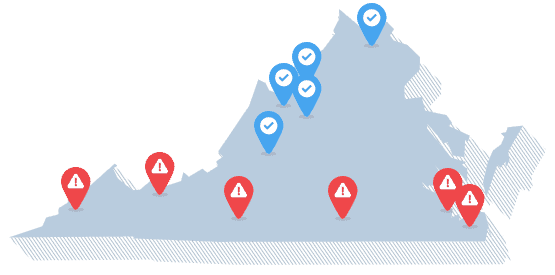The Safest and Most Dangerous Cities in Virginia

Virginia Security Solutions
The following is a list of cities that provide home security solutions in the state of Virginia
Virginia, one of only four states technically categorized as a “commonwealth,” is generally known for its rich history, diverse landscapes, and bustling economy. From the tech-centric city life of Arlington and Alexandria to the scenic beauty of the Blue Ridge Mountains, Virginia boasts an impressive array of attractions.
In terms of public safety, Virginia features a relatively low property crime rate and a low violent crime rate statewide. However, crime rates differ dramatically based on the area of Virginia you are in and are generally higher in the Hampton Roads region. For example, two Hampton Roads cities — Newport News and Portsmouth — have some of the highest crime rates in Virginia.
Virginia cities with the highest and lowest crime rates
(per 100,000 people)
| Cities with the highest property crime rates | |
|---|---|
| Norton | 9,980 |
| Rocky Mount | 6,279 |
| Bluefield | 5,165 |
| Cities with the highest violent crime rates | |
|---|---|
| Blackstone | 933 |
| Newport News | 875 |
| Portsmouth | 825 |
| Cities with the lowest property crime rates | |
|---|---|
| Grottoes | 268 |
| Broadway | 302 |
| Buena Vista | 319 |
| Cities with the lowest violent crime rates | |
|---|---|
| Berryville | 20 |
| Bridgewater | 29 |
| Timberville | 32 |
Note: Excluding cities with crime rates of zero. Source: 2023 FBI Data
Safest Cities and Towns in Virginia
Virginia, as mentioned, is considered to be one of the safer states in the country with below-average violent crime and property crime rates. The cities listed below can proudly boast relatively strong safety metrics, particularly in comparison to other cities in Virginia. It is worth noting that many of the safest cities are located in the southwestern portion of Virginia, particularly Rockingham County.
Berryville, a city located within the Shenandoah Valley (specifically Clark County), has one of the lowest violent crime rates in Virginia. This is a big reason why Berryville is generally considered to be a safe, family-friendly community.
The police chief of Berryville was interviewed about the city’s impressively-low crime rate and they stated that the low crime levels are “reflective of the efforts between the police department and the community to keep Berryville a safe place for everybody.”1 The Berryville Police Department takes proactive measures to maintain open lines of communication with the community.
In addition, police officers try to be approachable while on patrol. Officers routinely make presentations to community groups about how to stay safe and they are willing to stop by to do security checks at homes and businesses when owners or occupants are away for extended periods.
Grottoes, a town that is part of the Harrisonburg Metropolitan Statistical Area, has the lowest property crime rate in Virginia. This low crime rate and atmosphere of safety is probably very attractive to the many tourists who flock to Grottoes’ Grand Caverns each year.
Virginia’s Most Dangerous Cities
Not every portion of Virginia is safe. There are cities and towns with above-average crime rates. Both tourists and Virginia residents should exercise reasonable caution when traversing the cities below.
Of all the cities in Virginia, the historic small town of Blackstone (in Nottoway County) had the highest violent crime rate, with approximately 933 reported violent crimes per 100,000. The majority of the violent crimes were aggravated assaults, along with one robbery, committed in the reporting year. Despite the high crime rate, Blackstone has many initiatives to revitalize and preserve its historic business area and has several shops and restaurants.2
About 113 miles to the east of Blackstone lies Portsmouth and nearby Newport News. Unfortunately, both of these Hampton Roads cities face significant challenges when it comes to crime. Portsmouth is generally considered to be one of Virginia's most dangerous cities, with approximately 826 reported violent crimes per 100,000 residents.
The causes of Portsmouth’s crime challenges are complex and multifaceted. Many analysts believe the higher-than-average crime rates are driven mainly by a relatively high poverty rate and significant economic difficulties in the broader area. For example, the poverty rate in Portsmouth is higher than the national average.3
Where Virginia Stands Nationally
Virginia is generally considered to be one of the safer states in the country. Virginia is ranked 37th nationally in terms of reported violent crimes and 31st nationally in terms of reported property crimes.
Property crime rates
(per 100,000 residents)
| Crime Type | Virginia | National |
|---|---|---|
| Burglary | 122.4 | 250.7 |
| Larceny | 1363.5 | 1343.9 |
| Vehicle theft | 172.8 | 317.2 |
Violent crime in Virginia hovers at a relatively low rate of 236 per 100,000 residents annually, which is 35 percent below the national average. Property crime in Virginia occurred at a rate of 1,659 per 100,000 residents per year, which is approximately 13 percent below the national average.
Violent crime rates
(per 100,000 residents)
| Crime Type | Virginia | National |
|---|---|---|
| Murder/Non-negligent homicide | 6.0 | 5.7 |
| Aggravated assault | 162.8 | 263.7 |
| Robbery | 37.7 | 65.4 |
| Rape | 29.8 | 38.0 |
In terms of overarching safety trends in Virginia, the property crime rate declined by 2.2 percent when compared to the prior year. However, the violent crime rate increased by 0.9 percent when compared to the prior year.4
What Kinds of Crimes Are Most Common in Virginia?
Larceny-theft is the most common property crime in Virginia, with a rate 1.2 percent above the national average. For context, larceny crimes include stealing personal property, shoplifting, and other forms of theft that typically do not involve force or the threat of force.
Aggravated assault is the most common violent crime in Virginia, although the number of reported aggravated assaults still remains 38.4 percent below the national average. For context, aggravated assault, according to Virginia Criminal Code § 18.2-57,5 is defined as an unlawful attack by one person upon another for the purpose of inflicting severe or aggravated bodily injury.
It is worth noting that the murder rate is higher than average in Virginia. Specifically, the reported murder rate in Virginia is 5.3 percent above the national average.
Where Our Data Comes From
Unless specified otherwise, the information in this article is based on crime data compiled by the FBI and made available through the Crime Data Explorer. Statewide violent and property crime statistics are drawn from the FBI’s 2023 Crime in the United States Report (Table 5) and for city-level crime rates, we referred to Table 8, which lists reported offenses by state and city.
Important note: Crime statistics offer valuable insights, but they aren’t the only way to evaluate a community’s safety. Local context, law enforcement practices and reporting standards can all influence how crime is recorded. Additionally, FBI publication tables and the data displayed on the Crime Data Explorer may differ slightly due to variations in methodology.
Navigate Crime Data by State
- Alabama
- Alaska
- Arizona
- Arkansas
- California
- Colorado
- Connecticut
- Delaware
- Florida
- Georgia
- Hawaii
- Idaho
- Illinois
- Indiana
- Iowa
- Kansas
- Kentucky
- Louisiana
- Maine
- Maryland
- Massachusetts
- Michigan
- Minnesota
- Mississippi
- Missouri
- Montana
- Nebraska
- Nevada
- New Hampshire
- New Jersey
- New Mexico
- New York
- North Carolina
- North Dakota
- Ohio
- Oklahoma
- Oregon
- Pennsylvania
- Rhode Island
- South Carolina
- South Dakota
- Tennessee
- Texas
- Utah
- Vermont
- Washington
- West Virginia
- Wisconsin
- Wyoming
Citations
- The Winchester Star. (2024, Mar 18). Berryville still one of Virginia’s safest cities despite drop in ranking.
https://www.winchesterstar.com/winchester_star/berryville-still-one-of-virginias-safest-cities-despite-drop-in-ranking/article_41d36cfa-cd7e-5d64-800b-237b72a9a371.html - Downtown Blackstone Inc. (2024). Welcome to Downtown Blackstone.
https://downtownblackstone.org/ - 13News Now. (2024, Feb 6). Portsmouth poverty rate higher than national rate.
https://www.13newsnow.com/article/news/local/mycity/portsmouth/portsmouth-poverty-rate-higher-than-national-rate/291-65bc7335-5628-4f18-907e-878d32d264f1 - WRIC ABC 8News. (2024, Apr 5). Violent crime continues to rise statewide, according to Virginia 2023 report.
https://www.wric.com/news/virginia-news/violent-crime-continues-to-rise-stadewide-according-to-virginia-2023-report/ - Virginia General Assembly. (2024). § 18.2-57. Assault and battery; penalty.
https://law.lis.virginia.gov/vacode/title18.2/chapter4/section18.2-57/
